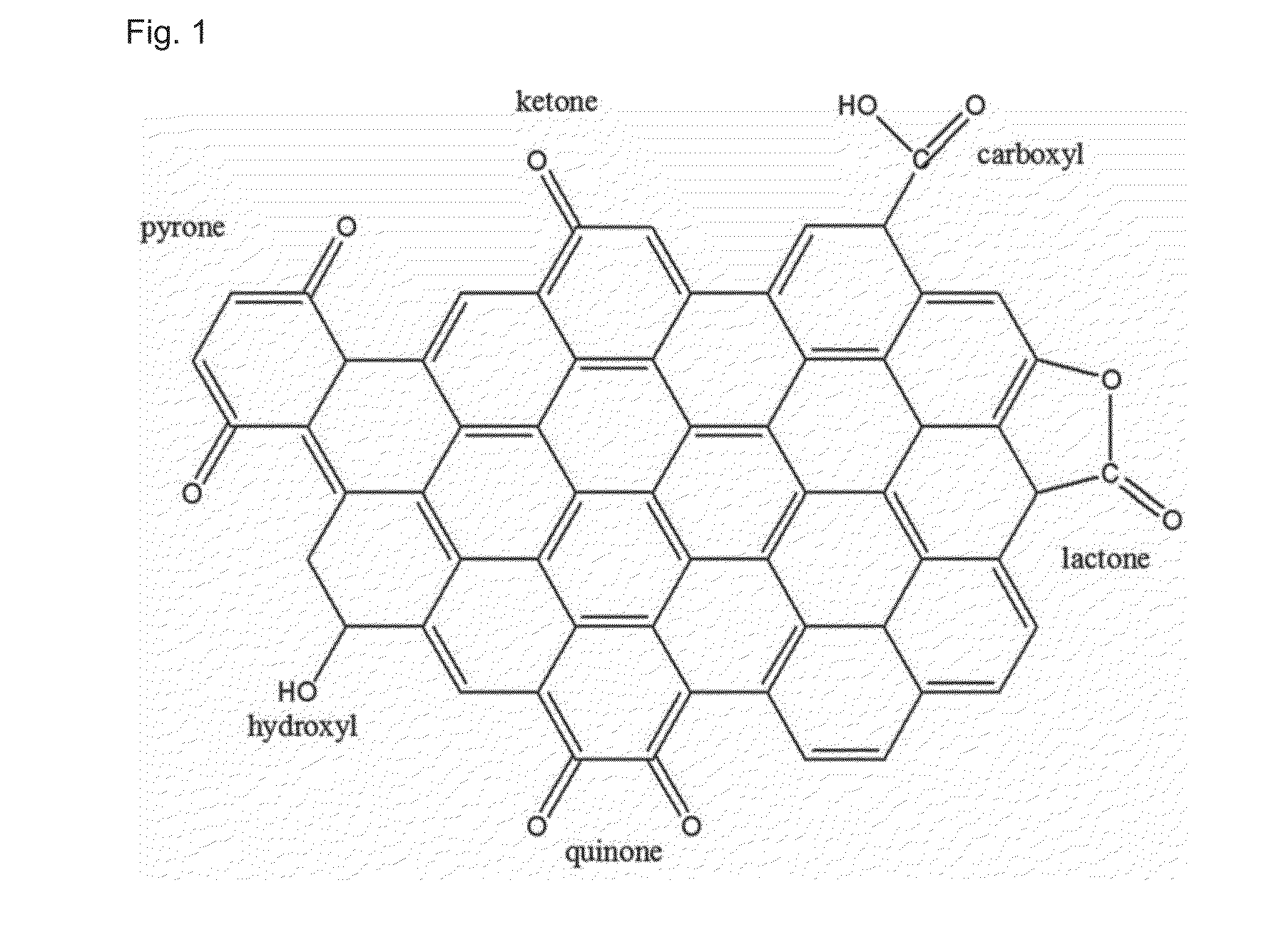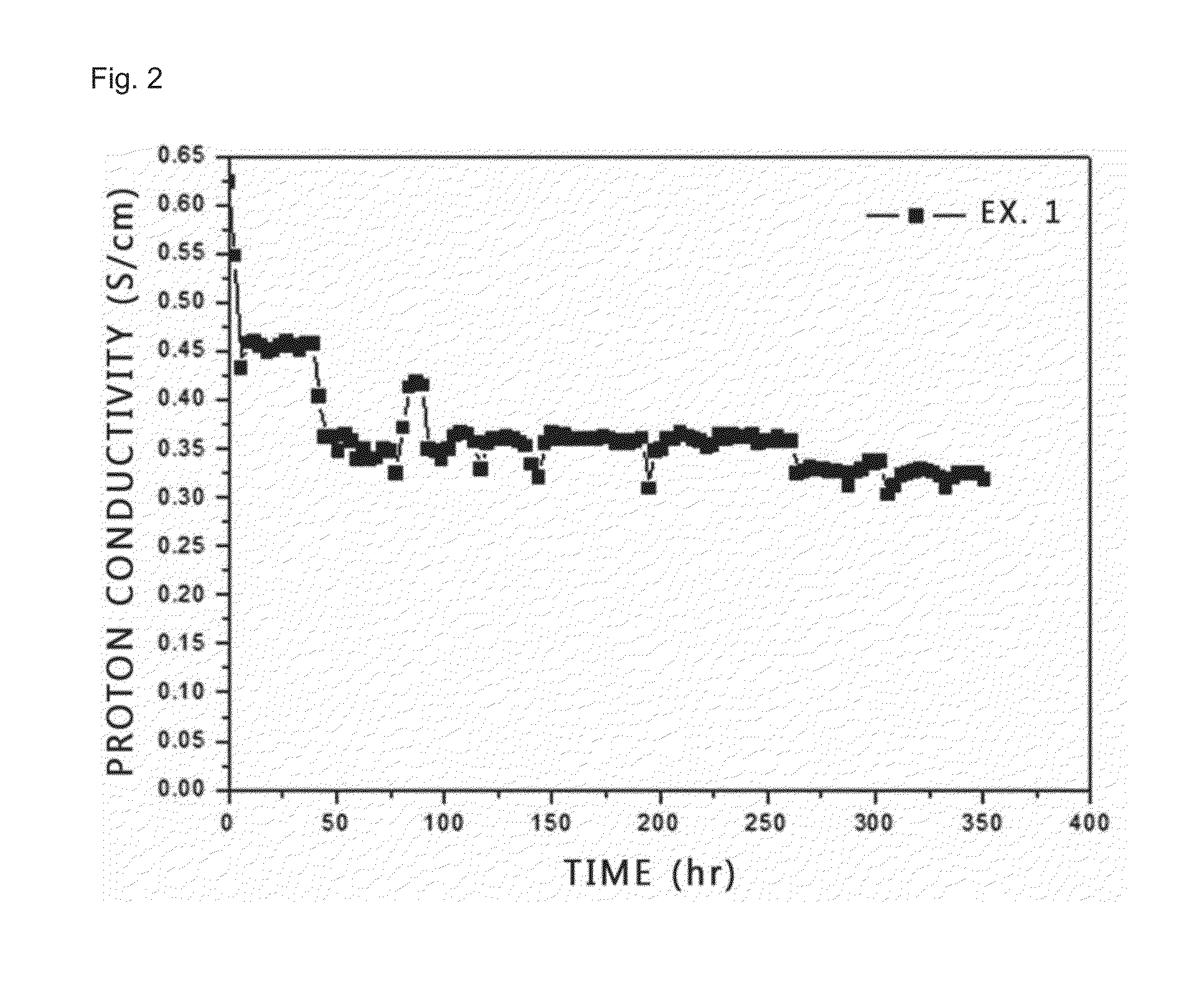Polymer electrolyte membrane for a fuel cell, method for manufacturing same, and fuel cell comprising same
a technology of polymer electrolyte and fuel cell, which is applied in the direction of fuel cell details, electrochemical generators, final product manufacturing, etc., can solve the problems of difficulty in providing high proton conductivity, low efficiency of electrolyte membrane impregnation with phosphoric acid, and rapid degradation of quality, so as to achieve high retention ratio, the effect of increasing the phosphoric acid doping level
- Summary
- Abstract
- Description
- Claims
- Application Information
AI Technical Summary
Benefits of technology
Problems solved by technology
Method used
Image
Examples
example 1
[0057]First 3.24 g (15.1 mmol) of 3,3′-diaminobenzidine and 2.51 g (15.1 mmol) of isophthalic acid are dissolved in 160 g of polyphosphoric acid. Next, the reaction mixture is heated to a temperature of 220° C. under nitrogen atmosphere in a system equipped with a reflux device and reaction is carried out for 30 hours.
[0058]After the completion of the reaction, precipitate is collected in water. Then, neutralization is carried out with potassium hydroxide (KOH) to pH 7. The reaction mixture is washed thoroughly with boiling water, filtered and dried in a vacuum oven for 24 hours. The obtained m-PBI powder is added to a solution in which carbon black is dispersed preliminarily in methanesulfonic acid in an amount of 10 parts by weight based on 100 parts by weight of polybenzimidazole polymer and the dissolved therein, followed by casting of a membrane. Then, the membrane is cured in an oven in a stepwise manner at 80° C. for 1 hour, at 100° C. for 1 hour, at 120° C. for 1 hour and at...
example 2
[0059]First, 3.24 g (15.1 mmol) of 3,3′-diaminobenzidine and 2.51 g (15.1 mmol) of isophthalic acid are dissolved in 160 g of polyphosphoric acid together with 10 parts by weight of carbon black based on 100 parts by weight of polybenzimidazole polymer. Next, the reaction mixture is heated to a temperature of 220° C. under nitrogen atmosphere in a system equipped with a reflux device and reaction is carried out for 30 hours.
[0060]After the completion of the reaction, precipitate is collected in water. Then, neutralization is carried out with potassium hydroxide (KOH) to pH 7. The reaction mixture is washed thoroughly with boiling water, filtered and dried in a vacuum oven for 24 hours. The obtained m-PBI powder is dispersed in methanesulfonic acid, followed by casting of a membrane. Then, the membrane is cured in an oven in a stepwise manner at 80° C. for 1 hour, at 100° C. for 1 hour, at 120° C. for 1 hour and at 160° C. for 2 hours to obtain an electrolyte membrane for a fuel cell...
example 3
Manufacture of Electrolyte Membrane Including Carbon Black and Silica-Based Metal-Grafted Porous Filler Dispersed Therein
(1) Preparation of Silica-Based Metal-Grafted Porous Filler
[0072]To obtain a metal-grafted porous filler, 2 g of hexadecyltrimethyl ammonium bromide and 0.3 g of Brij-30 are dissolved in 38 g of distilled water, and 1 g of aluminum chloride is introduced to and dispersed in the solution. Then, 9 g of sodium silicate solution is added gradually thereto and the resultant mixture is introduced to an oven at 100° C. to carry out reaction for 2 days. The reaction mixture is taken out of the oven and cooled to room temperature. Next, 50% acetic acid solution is used to carry out titration of the solution gradually to pH 10. When pH reaches 10, the solution is introduced to an oven at 100° C. to carry out reaction for 2 days. The procedure including pH titration and reaction in an oven at 100° C. is repeated twice to have a sufficient period of time so that no change in ...
PUM
| Property | Measurement | Unit |
|---|---|---|
| temperature | aaaaa | aaaaa |
| temperature | aaaaa | aaaaa |
| temperature | aaaaa | aaaaa |
Abstract
Description
Claims
Application Information
 Login to View More
Login to View More - R&D
- Intellectual Property
- Life Sciences
- Materials
- Tech Scout
- Unparalleled Data Quality
- Higher Quality Content
- 60% Fewer Hallucinations
Browse by: Latest US Patents, China's latest patents, Technical Efficacy Thesaurus, Application Domain, Technology Topic, Popular Technical Reports.
© 2025 PatSnap. All rights reserved.Legal|Privacy policy|Modern Slavery Act Transparency Statement|Sitemap|About US| Contact US: help@patsnap.com



